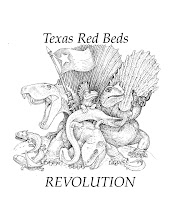Though the Permian period did have large predators - like the 600-pound Dimetrodon and the 8-foot Eryops - it was dominated by small creatures, with small bones (called microfossils). Here, teachers and volunteers on the museum's team look for fossils that might lead to an excavation site.
Is this anything special?
Fossils look a lot like rocks - because that's what they are. Over millions of years, the materials that make up an organic bone are replaced with the minerals that surround the bone as it is buried - eventually resulting in a bone-shaped rock. Which means that looking for fossils on the surface takes a little bit of training.
As it turned out, this is pretty special - as they dug beneath the surface, the team discovered an associated Dimetrodon skeleton, including parts of a skull, backbone, legs and several of the spines that supported the impressive back-fin this species is known for.
A team member examines a find using a jeweler's scope to discover whether it is a fossil, and if so, what kind.
The team uses GPS navigation tools to map the locations of fossil beds they have found. This way, they can determine the geologic layer each site rests in as well as its relation to the other sites.
Here, team members Chris Flis and Johnny Castillo dig around an articulated Dimetrodon spine. They are looking for evidence of additional fossil remains. If more remains are found, the area of excavation will widen. If not, they will continue preparing the spine to be "jacketed" with plaster before it is removed from the site.
The original spine has been jacketed with plaster to stabilize it, as the team continues to excavate around it. Several vertebrae and other Dimetrodon bones continue to be discovered at this site, raising hopes that it may contain an entire associated Dimetrodon.
The team has completely excavated this layer. The next step will be to dig underneath the plaster jackets, flip them, plaster the bottom to seal the casing and remove them from the site. Then, the jackets will be taken to the museum for further preparation and study.
Dr. Bakker begins to dig beneath one of the jackets, in order to start the process of removal, and discovers yet another fossil.
After the jacket is completed, Johnny Castillo and Chris Flis take it out of the site, to be transported back to the Museum.
Back at the Museum, Dr. Bakker works with volunteers and visitors to continue excavating fossils from the contents of one of the plaster jackets brought from the site in Seymour. Earlier on this day, a young boy found an unidentified claw in the matrix. Could it be a new species?
Once a fossil has been completely freed from the dirt and other material that surround it, it's ready to be put on display. This Dimetrodon hip fossil (found by teacher David Henderson) is currently on display at the Houston Museum of Natural Science.



+of+seymourolym6.4.-5+064.JPG)









